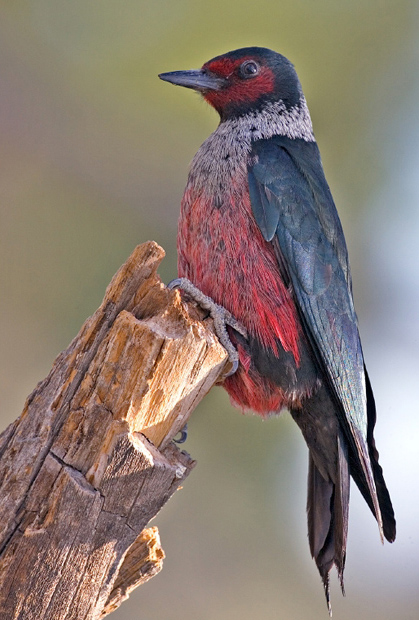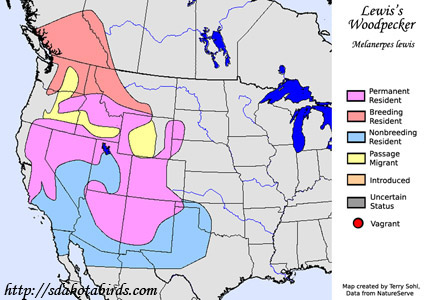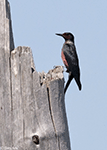| Length: 11 inches | Wingspan: 20 inches | Seasonality: All Seasons |
| ID Keys: Pink belly, dark greenish back, red face, gray collar | ||
 Lewis's
Woodpeckers are unusual woodpeckers of the Black Hills of South Dakota (and
occasionally elsewhere in the far western part of the state). In
addition to their unique plumage, they often act more like flycatchers when
foraging, as they fly out from perches to catch insects in mid-air. They
also have an unusual flight pattern for a woodpecker, without the typical
woodpecker undulating flight, and more of a steady, level flight like a crow. They were first discovered on the Lewis and Clark expedition in
1804, and were named after Meriwether Lewis.
Lewis's
Woodpeckers are unusual woodpeckers of the Black Hills of South Dakota (and
occasionally elsewhere in the far western part of the state). In
addition to their unique plumage, they often act more like flycatchers when
foraging, as they fly out from perches to catch insects in mid-air. They
also have an unusual flight pattern for a woodpecker, without the typical
woodpecker undulating flight, and more of a steady, level flight like a crow. They were first discovered on the Lewis and Clark expedition in
1804, and were named after Meriwether Lewis.
Habitat:
Requires open areas for aerial foraging habits. Often found in burned areas, clear-cut areas, and cottonwood groves and other riverside groves.
Diet:
Feeds on many insects during the summer months. Feeds on fruits, berries, and nuts in all seasons.
Behavior:
Uses a variety of foraging techniques, depending upon season and local conditions. Much of its foraging is done by flying out from a perch and catching flying insects in mid-air. They will also glean insects from foliage and tree limbs, and feed on fruits, nuts, and berries in the canopy, in shrubs, or on the ground.
Nesting:
June and July in South Dakota. The nest of a Lewis's Woodpecker is a cavity in a tree. The female lays between 5 and 8 eggs, and both parents help to incubate them. Upon hatching, both the male and female fed the young, who leave the nest after about one month.
Song:
Usually silent, although they will make weak chattering or chirring notes.
1Click here to hear a chirring call of a Lewis's Woodpecker
2Click here to hear the various calls of a group of Lewis's Woodpecker
3Click here to hear various calls and the drumming of a male Lewis's Woodpecker
Migration:
Migrates erratically, with some populations being permanent residents, while others routinely move to lower elevations in the winter. Winter conditions and/or food availability occasionally result in larger scale migrations.
Interactive eBird Map:
Click here to access an interactive eBird map of Lewis's Woodpecker sightings
Similar Species:
Generally distinctive, and unlikely to be confused with other species.
Feeders:
Will occasionally attend feeders for suet, also for various fruits.
Conservation Status:
Lewis's Woodpeckers have disappeared from many of their former breeding grounds in the western United States, and systematic surveys continue to indicate declines in many parts of their range. However, declines are not yet enough for serious concern about populations overall, and the IUCN currently lists the Lewis's Woodpecker as a species of "Least Concern".
Further Information:
Photo information:
Audio File Credits:
1Frank Lambert. Recorded in Delta County, Colorado on April 22nd, 2015. Original recording and information available on xeno-canto.
2Bruce Lagerquist. Recorded in Yakima County, Washington on April 2nd, 2016. Original recording and information available on xeno-canto.
3Andrew Spencer. Recorded in Montezuma County, Colorado May 27th, 2007. Original recording and information available on xeno-canto.
| Click on the map below for a higher-resolution view |
 |
| South Dakota Status: Uncommon permanent resident in and around the Black Hills. |
Additional Lewis's Woodpecker Images
Click for a higher-resolution version of these photos


